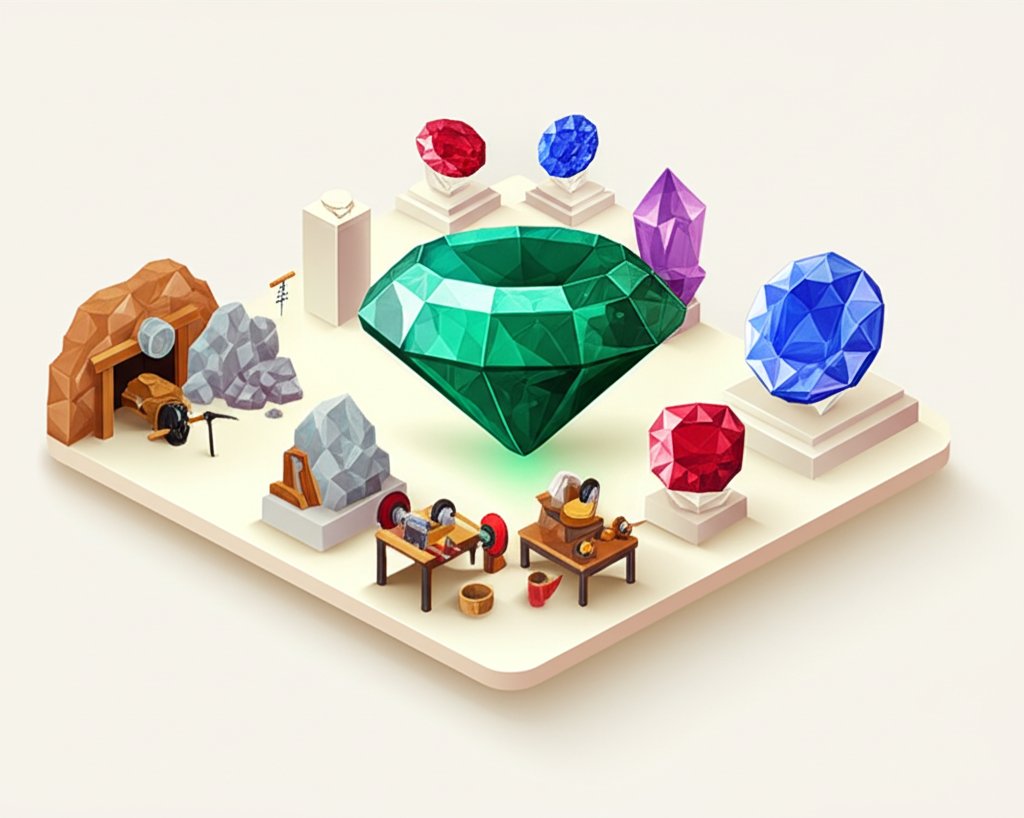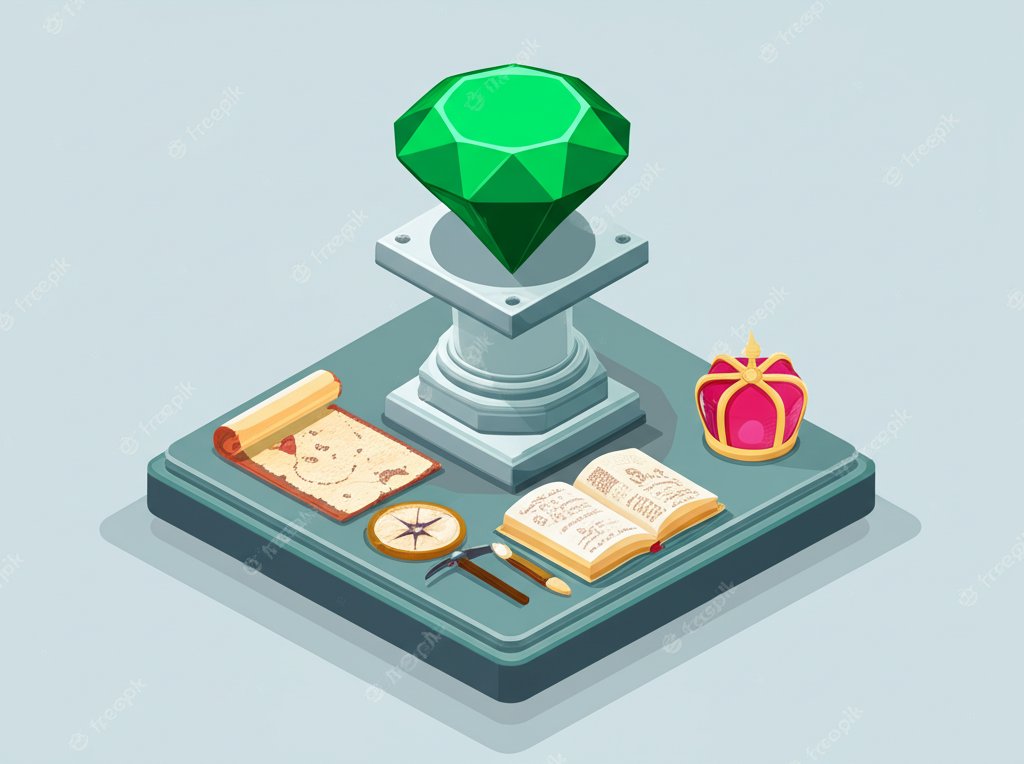Step into a world where beauty meets untold stories, where the Earth’s treasures whisper tales of kings, curses, and captivating legacies. From the dazzling depths of the Hope Diamond to the ancient allure of Egyptian lapis lazuli, famous gemstone history unfurls a vibrant tapestry woven through millennia of human civilization. These aren’t just mere stones; they are silent witnesses to pivotal moments, objects of power, symbols of love, and sources of endless fascination.
In this comprehensive guide, we’ll embark on an extraordinary journey through gemstone history, uncovering the origins, cultural significance, and enduring appeal of the world’s most renowned jewels. Prepare to delve into the secrets of legendary gems, explore the lives of famous gemstones, and unravel the captivating gemstone legends that continue to enchant us. Our mission is to illuminate every facet of these magnificent minerals, providing a superior resource that details their remarkable journeys from rough stone to revered icon.
The Dawn of Adornment: Gemstone Origins & Ancient Civilizations
The story of humanity and gemstones began long before recorded history, as early humans discovered and cherished vibrant stones for their intrinsic beauty and perceived mystical properties. The very first gemstone history is etched in the crude adornments of our ancestors, who recognized something extraordinary in these glittering minerals. As civilizations rose, so too did the sophistication of their relationship with these natural wonders, transforming them into symbols of status, spirituality, and wealth. These early historical gemstones laid the foundation for the legends that would follow.
Echoes from the Nile: Lapis Lazuli and Turquoise in Ancient Egypt
Few civilizations embraced the power of gemstones quite like the ancient Egyptians. Their reverence for color and symbolism made lapis lazuli and turquoise paramount among their treasures. Lapis lazuli, with its deep celestial blue flecked with golden pyrite, was equated with the heavens and the gods. It adorned pharaohs, goddesses, and was ground into powder for cosmetics, believed to offer protection and bring the wearer closer to the divine. The Death Mask of Tutankhamun, a pinnacle of ancient craftsmanship, is famously inlaid with lapis lazuli, testifying to its royal significance.
Turquoise, meanwhile, was mined in the Sinai Peninsula – a grueling and dangerous endeavor that only enhanced its value. Egyptians called it “mefkat,” meaning “joy” and “delight,” and believed it possessed protective qualities against evil and brought good fortune. It was frequently used in amulets and jewelry, often carved into scarabs, representing rebirth and eternal life. The bright, sky-blue hue was seen as a connection to the life-giving waters of the Nile and the azure sky.
Imperial Green: Jade’s Reign in Ancient China
Across the globe, jade held an unparalleled position in ancient Chinese culture, deeply intertwined with spiritual beliefs, imperial power, and philosophical ideals. Far more than just a beautiful stone, jade symbolized purity, wisdom, longevity, and even immortality. Its gemstone history in China spans over 7,000 years, making it one of the most enduring precious materials.
From Neolithic tools to elaborate imperial artifacts, jade was meticulously carved into ceremonial weapons, ritual objects, decorative ornaments, and exquisite jewelry. The intricate craftsmanship applied to jade reflected the belief that its inherent qualities could be transferred to the wearer. Emperors and nobles were often buried in jade suits or with jade plugs placed in their orifices, an attempt to preserve the body and ensure eternal life. The vibrant green nephrite and jadeite varieties captivated the hearts of emperors and scholars alike, cementing its status as “the Stone of Heaven.”
Greco-Roman Splendor: Amethyst, Garnet, and Carnelian
The ancient Greeks and Romans, known for their sophisticated artistry and mythology, also held a deep appreciation for historical gemstones. They valued stones not only for their beauty but also for their supposed magical and medicinal properties.
Amethyst, with its rich purple hues reminiscent of wine, was believed to ward off intoxication. Its name derives from the Greek “amethystos,” meaning “not drunk.” Roman revelers would often wear amethyst rings or drink from amethyst goblets, trusting in its protective powers against overindulgence.
Garnet, a fiery red stone, was thought to grant strength, protect travelers, and symbolize love and passion. Often used in signet rings and intricate intaglios, garnets were popular among Roman soldiers and nobility. The vibrant red was connected to life, vitality, and a brave heart.
Carnelian, a stone of orange-red warmth, was prized for its beauty and believed to instill courage, good luck, and protect against negative energy. It was widely used in seals, amulets, and jewelry across both cultures, frequently engraved with images of gods or heroes. These gems were more than adornments; they were talismans, imbued with meaning and power derived from gemstone legends.
Medieval Mysticism and the Rise of European Royalty

As the Roman Empire faded, the focus on gemstones shifted in medieval Europe. While still prized for their beauty, stones became deeply intertwined with Christian symbolism, alchemy, and the emerging power structures of feudal lords and monarchy. The gemstone history of this period is rich with superstition and theological interpretation.
Stones of Protection and Power: Rubies and Sapphires
In medieval Europe, rubies and sapphires emerged as paramount famous gemstones, particularly favored by royalty and religious institutions. Rubies, associated with the shedding of Christ’s blood and kingly power, were believed to confer invulnerability, health, and wealth upon their wearers. They adorned crowns, reliquaries, and ecclesiastical vestments, signifying divine authority.
Sapphires, with their celestial blue, were linked to the heavens, purity, and truth. Knights wore sapphires for protection in battle and to ensure victory, believing the stone possessed magical powers. Bishops wore sapphire rings as a symbol of their office, representing their connection to the divine. The deeper the blue, the more potent its perceived spiritual energy. These stones were not merely decorative; they were conduits of spiritual and temporal power, shaping gemstone legends for centuries to come.
The Allure of Alchemists: Gemstones and Esoteric Beliefs
Beyond the church and court, historical gemstones fascinated alchemists and mystics. Each stone was thought to possess specific energetic properties that could influence health, fate, and spiritual enlightenment. Texts like the “Lapidary” (books on stones) cataloged these beliefs, detailing which stones could cure ailments, attract love, or repel evil spirits.
For instance, emerald was believed to promote good eyesight and reveal truth, while pearls were associated with purity and innocence. The study of these stones, often imbued with gemstone legends passed down orally and in manuscripts, formed a significant part of medieval scientific and philosophical inquiry. This era solidified the idea that gems held secrets beyond their material composition, contributing immensely to the mystique surrounding famous gemstone history.
The Age of Exploration: Discovering New Treasures and Dynastic Jewels
The discovery of new trade routes and continents during the Renaissance and Age of Exploration dramatically expanded the world’s access to exotic historical gemstones. This period saw an influx of diamonds from India, emeralds from Colombia, and new varieties of pearls, forever changing the landscape of jewelry and royal treasuries. The pursuit of these dazzling minerals fueled expeditions, ignited wars, and left an indelible mark on gemstone history.
India’s Diamond Legacy: Koh-i-Noor, Regent, and the Golconda Mines
India, particularly the fabled Golconda mines, was the primary source of the world’s most spectacular diamonds for centuries. From these mines emerged a lineage of famous gemstones that would become legendary.
The Koh-i-Noor Diamond, meaning “Mountain of Light,” has perhaps the most dramatic and blood-soaked gemstone history. Its journey spans from ancient Indian rulers to Persian shahs, Afghan emirs, and finally to the British Crown Jewels. Whispers of a curse upon any male who wears it have surrounded this massive diamond, adding to its compelling gemstone legends. Originally weighing 186 carats, it was recut to its current 105.6 carats and now rests in the Queen Mother’s Crown, displayed in the Tower of London.
Another marvel from Golconda is the Regent Diamond. Discovered in 1698, this stunning 140.64-carat cushion-cut diamond passed through the hands of many French monarchs, adorning the crowns of Louis XV and Louis XVI, and even Napoleon’s sword hilt. It survived the French Revolution and is now a prized possession of the Louvre Museum, a testament to its enduring beauty and integral role in famous gemstone history.
The Hope Diamond: A Tale of Beauty, Curse, and Intrigue
Perhaps no single jewel encapsulates the allure and mystery of famous gemstones quite like the Hope Diamond. Its deep blue color, extraordinary size (45.52 carats), and captivating (if sensationalized) curse have made it a symbol of both breathtaking beauty and tragic fate.
The gemstone history of the Hope Diamond begins in India as the Tavernier Blue, a much larger, roughly cut diamond. After being stolen and recut, it eventually made its way into the French Crown Jewels as the French Blue. During the French Revolution, it was stolen again, only to resurface years later in a smaller, recut form as the Hope Diamond, named after a prominent banking family who acquired it.
Its subsequent owners faced a string of misfortunes – financial ruin, suicide, murder, and madness – fueling the gemstone legends of its cursed nature. Whether true or mere coincidence, these stories have only amplified its mystique. Today, the Hope Diamond resides in the Smithsonian National Museum of Natural History, drawing millions of visitors eager to gaze upon its storied brilliance.
Modern Marvels: Unveiling the World’s Most Famous Gemstones
The 19th and 20th centuries brought new discoveries, particularly of diamonds in South Africa, and advancements in gem cutting techniques. This era cemented the cultural significance of certain famous gemstones and introduced new icons that captured the global imagination. The modern chapter of gemstone history sees these treasures not only as symbols of power but also as pinnacles of human artistry and natural wonder.
The Cullinan Diamond: A Fragment of Forever
The Cullinan Diamond, discovered in South Africa in 1905, is an undisputed titan among historical gemstones. Weighing an astonishing 3,106 carats in its rough state, it remains the largest gem-quality rough diamond ever found. Its sheer size presented an unprecedented challenge to cutters, leading to the creation of nine major stones and 96 smaller brilliant-cut diamonds.
The two largest facets, Cullinan I (the “Great Star of Africa,” 530.20 carats) and Cullinan II (the “Second Star of Africa,” 317.40 carats), are now integral parts of the British Crown Jewels. Cullinan I famously adorns the Sovereign’s Sceptre with Cross, while Cullinan II is set in the Imperial State Crown. The splitting and cutting of the Cullinan was a monumental feat, symbolizing the apex of diamond craftsmanship and adding a magnificent chapter to famous gemstone history.
Star of India: The World’s Largest Star Sapphire
Beyond diamonds, other famous gemstones have carved out their own legendary status. The Star of India, a colossal 563.35-carat star sapphire, stands as one of the largest and most famous examples of its kind. Its unique asterism—a six-rayed star that shimmers across its surface—is a natural phenomenon known as chatoyancy, highly prized in star sapphires.
Discovered in Sri Lanka (then Ceylon) approximately 300 years ago, its gemstone history includes being donated to the American Museum of Natural History by banker J.P. Morgan. Despite a brief theft in 1964, it was recovered and remains a star attraction, showcasing the breathtaking beauty and geological wonders inherent in historical gemstones beyond the diamond family. It’s a prime example of how gemstone legends can be built around unique natural characteristics.
Engagement Ring Icons: From Tiffany Yellow to Cartier’s Pink
In the modern era, famous gemstones have also become synonymous with personal milestones and luxury branding. The tradition of diamond engagement rings, popularized in the 20th century, has led to numerous iconic individual gems.
The Tiffany Yellow Diamond, a magnificent 128.54-carat cushion-cut yellow diamond, is one of the largest yellow diamonds ever discovered. Unearthed in the Kimberley mines of South Africa in 1878, it has famously been worn by only a few women, including Audrey Hepburn and Lady Gaga, serving as a symbol of unparalleled elegance and luxury.
Another notable example is the 24.78-carat Graff Pink Diamond, a vibrant fancy intense pink emerald cut diamond sold for a record-breaking sum in 2010. Its rarity and exceptional color place it among the most coveted famous gemstones in the world, embodying the modern appreciation for unique hues and ultimate luxury. These contemporary examples continue to write the dynamic gemstone history for future generations.
Gemstone Legends and Lore: Myth, Magic, and Meaning
The enduring appeal of historical gemstones is perhaps most deeply rooted in the rich tapestry of gemstone legends and lore that accompany them. Across cultures and throughout time, humans have ascribed supernatural powers, symbolic meanings, and even curses to these precious stones, transforming them from inert minerals into active participants in human drama and belief systems. Understanding these narratives is crucial to appreciating the full scope of gemstone history.
Birthstones: A Modern Connection to Ancient Beliefs
One of the most widely recognized gemstone legends in modern times is the concept of birthstones. This tradition, associating a specific gemstone with each month of the year, can be traced back to the Breastplate of Aaron described in the Book of Exodus, which contained twelve different gemstones representing the twelve tribes of Israel. Over time, these stones became linked to the twelve signs of the zodiac and eventually to individual birth months.
Each birthstone carries its own set of symbolic meanings and purported properties. For example:
This enduring tradition ensures that gemstone history and gemstone legends remain a personal and cherished part of many people’s lives today.
Curses and Blessings: Superstitions Surrounding Legendary Gems
Beyond birthstones, many famous gemstones are steeped in specific stories of curses, blessings, and powerful omens. These gemstone legends often arise from the tumultuous histories of royal courts, conflicts over ownership, or sudden misfortunes befalling those who possessed them.
The aforementioned Hope Diamond is arguably the most famous example of a “cursed” gem, with tales of despair and death following its owners. Similarly, the Koh-i-Noor Diamond has a long-standing legend that “he who owns this diamond will own the world, but will also know all its misfortunes.” While these stories often serve to romanticize and enhance the mystique of the stones, they also reflect humanity’s innate tendency to attribute cosmic significance to objects of extraordinary beauty and immense value.
These tales of magic, prosperity, and peril are fundamental to the rich tapestry of famous gemstone history, demonstrating how these treasures have always been more than just inert minerals – they are woven into the very fabric of human belief and storytelling.
Conclusion: The Everlasting Allure of Legendary Gems

From the earliest chipped flints used for adornment to the dazzling masterpieces housed in modern museums, the famous gemstone history is a continuous narrative of human discovery, innovation, and reverence. These radiant gems, with their unparalleled beauty and profound gemstone legends, have consistently captivated humanity, serving as potent symbols of wealth, power, love, and spirituality across every civilization.
As we’ve journeyed through millennia, exploring the historical gemstones of ancient Egypt and China, the mystical jewels of medieval Europe, and the iconic diamonds that have graced kings and queens, it becomes clear that their allure is timeless. Each famous gemstone tells a unique story, an intricate blend of geological marvel, human ambition, and cultural interpretation.
The quest for these “secrets of legendary gems” continues to drive exploration, inspire artistry, and spark wonder. Their vibrant colors, enduring hardness, and profound historical connections ensure that gemstone history will forever remain a fascinating and illuminating mirror reflecting human civilization itself. Continue to explore this enchanting world; for within each shimmering facet lies a tale waiting to be discovered, connecting us to a rich past and an endlessly beautiful present.
FAQ: Unveiling More Secrets of Famous Gemstones
Q1: What is considered the oldest famous gemstone in history?
A1: While specific “famous” individual gemstones are relatively modern, the use of certain types of gemstones dates back to the earliest human civilizations. For example, jade has a documented gemstone history in China spanning over 7,000 years, and lapis lazuli was highly prized in ancient Egypt over 5,000 years ago, making them among the oldest historical gemstones in continuous human appreciation.
Q2: Which famous gemstone is believed to be cursed?
A2: The Hope Diamond is the most renowned famous gemstone associated with a curse. While purely anecdotal, its gemstone legends claim a string of misfortunes, including financial ruin, suicide, and murder, have befallen its various owners throughout gemstone history.
Q3: What were the primary uses of gemstones in ancient civilizations?
A3: Ancient civilizations used historical gemstones for a wide array of purposes, including:
Q4: Where did many of the world’s most famous diamonds originate?
A4: Many of the world’s most famous gemstones, particularly diamonds like the Koh-i-Noor, Regent, and Hope Diamond, originated from the legendary Golconda mines in India before discoveries in Brazil and later South Africa revolutionized the diamond market. South Africa became a major source for later finds like the Cullinan Diamond.
Q5: How did medieval Europe view gemstones differently from ancient cultures?
A5: While ancient cultures often saw gemstones as symbols of divinity and power, medieval Europe added layers of Christian symbolism and alchemical belief. Historical gemstones were frequently associated with specific saints, healing properties, magical powers, and ethical virtues, making them integral to religious vestments, knightly armor, and esoteric practices, enriching their gemstone legends.
Q6: What is a “birthstone” and where does the tradition come from?
A6: A birthstone is a gemstone associated with a specific birth month, believed to bring luck or possess unique properties to the wearer. The tradition is thought to originate from the Breastplate of Aaron mentioned in the Bible, which contained twelve stones representing the twelve tribes of Israel, later evolving into associations with the zodiac and individual months, becoming a widespread modern gemstone legend.
Q7: Are there any famous gemstones that are not diamonds?
A7: Absolutely! Many famous gemstones are not diamonds. Notable examples include:
These examples demonstrate the diverse and rich gemstone history beyond just diamonds.
“@context”: “https://schema.org”,
“@type”: “FAQPage”,
“mainEntity”: [
“@type”: “Question”,
“name”: “What is considered the oldest famous gemstone in history?”,
“acceptedAnswer”: {
“@type”: “Answer”,
“text”: “While specific \”famous\” individual gemstones are relatively modern, the use of certain types of gemstones dates back to the earliest human civilizations. For example, jade has a documented gemstone history in China spanning over 7,000 years, and lapis lazuli was highly prized in ancient Egypt over 5,000 years ago, making them among the oldest historical gemstones in continuous human appreciation.”
“@type”: “Question”,
“name”: “Which famous gemstone is believed to be cursed?”,
“acceptedAnswer”: {
“@type”: “Answer”,
“text”: “The Hope Diamond is the most renowned famous gemstone associated with a curse. While purely anecdotal, its gemstone legends claim a string of misfortunes, including financial ruin, suicide, and murder, have befalled its various owners throughout gemstone history.”
“@type”: “Question”,
“name”: “What were the primary uses of gemstones in ancient civilizations?”,
“acceptedAnswer”: {
“@type”: “Answer”,
“text”: “Ancient civilizations used historical gemstones for a wide array of purposes, including: Adornment (jewelry, amulets, regal); Religious & Spiritual (offerings, talismans, rituals); Symbolic (deities, status, power); Medicinal (cures, well-being); and Practical (tools, pigments).”
“@type”: “Question”,
“name”: “Where did many of the world’s most famous diamonds originate?”,
“acceptedAnswer”: {
“@type”: “Answer”,
“text”: “Many of the world’s most famous gemstones, particularly diamonds like the Koh-i-Noor, Regent, and Hope Diamond, originated from the legendary Golconda mines in India before discoveries in Brazil and later South Africa revolutionized the diamond market. South Africa became a major source for later finds like the Cullinan Diamond.”
“@type”: “Question”,
“name”: “How did medieval Europe view gemstones differently from ancient cultures?”,
“acceptedAnswer”: {
“@type”: “Answer”,
“text”: “While ancient cultures often saw gemstones as symbols of divinity and power, medieval Europe added layers of Christian symbolism and alchemical belief. Historical gemstones were frequently associated with specific saints, healing properties, magical powers, and ethical virtues, making them integral to religious vestments, knightly armor, and esoteric practices, enriching their gemstone legends.”
“@type”: “Question”,
“name”: “What is a \”birthstone\” and where does the tradition come from?”,
“acceptedAnswer”: {
“@type”: “Answer”,
“text”: “A birthstone is a gemstone associated with a specific birth month, believed to bring luck or possess unique properties to the wearer. The tradition is thought to originate from the Breastplate of Aaron mentioned in the Bible, which contained twelve stones representing the twelve tribes of Israel, later evolving into associations with the zodiac and individual months, becoming a widespread modern gemstone legend.”
“@type”: “Question”,
“name”: “Are there any famous gemstones that are not diamonds?”,
“acceptedAnswer”: {
“@type”: “Answer”,
“text”: “Absolutely! Many famous gemstones are not diamonds. Notable examples include: The Star of India (a massive star sapphire), the Black Prince’s Ruby (a large red spinel in the British Crown Jewels), the Emeralds of the Spanish Crown (legendary Colombian emeralds), and the Imperial Jadeite Cabbage (a famous jade sculpture from Taiwan). These examples demonstrate the diverse and rich gemstone history beyond just diamonds.”










